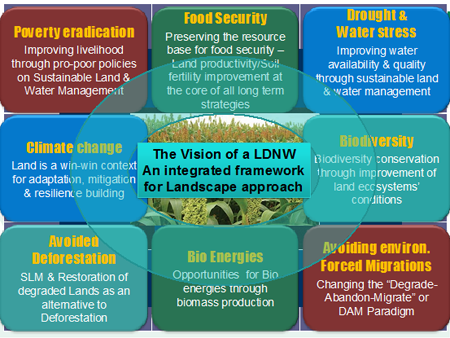Unlike the recently concluded climate change conference in Warsaw, the 11th session of the Conference of the Parties (COP 11) to the UN Convention to Combat Desertification (UNCCD) in September generated few headlines.
Yet the stories of the two processes are inextricably linked.
Unlike the recently concluded climate change conference in Warsaw, the 11th session of the Conference of the Parties (COP 11) to the UN Convention to Combat Desertification (UNCCD) in September generated few headlines. Yet the stories of the two processes are inextricably linked. As momentum towards a post-2015 development framework continues to accelerate, we would be well advised to revisit the relationship between climate change and desertification because, without protecting land and soils, all the best laid plans for coping with climate change will literally be swept from under our feet.
Prior to COP 11, which also marked my last COP as UNCCD Executive Secretary, we marked two important milestones. The first was the inclusion of the vision of striving towards a land-degradation neutral world (LDNW) in the Rio+20 outcome document. LDNW requires all countries to prevent or avoid the degradation of healthy and productive lands through sustainable land management practices and, where feasible, regenerate land that is already degraded. The aim of course is to restore more than we degrade; therefore, this vision calls for a goal and targets in order to reach, as soon as possible, the break-even point between degradation and restoration. The second achievement was the broad consensus that was reached during the High-Level meeting on National Drought Policy, which convened in Geneva in February 2013, calling on all drought-prone countries to move away from crisis management towards preparedness and disaster risk management.
At COP 11, a key area of debate was whether the scope for LDNW and its related goal, targets and legal instrument should be restricted to drylands. In order to move forward on this issue in the context of the “The Future We Want” parties decided to set up an Intergovernmental Working Group, whose core task is to develop options for achieving land-degradation neutrality. I expect this discussion will also include proposing practical targets for countries, with a strong monitoring component. However, for a LDNW to become reality, the aspirations expressed in the five paragraphs (205–209) of the Rio+20 outcome document, relating to drought, land degradation and desertification (DLDD), need to be incorporated in the broader set of goals and actions that will emerge from the post-2015 process.
Linking land and soils to other sustainable development goals
The Rio+20 outcome document recognizes the economic and social significance of good land management, including soil, to “economic growth, biodiversity, sustainable agriculture and food security, eradicating poverty, women’s empowerment, addressing climate change and improving water availability.”
The landscape is the appropriate scale where synergies and tradeoffs in making policy decisions and investments on each of those eight avenues can be best assessed, as well as options for transforming tradeoffs into synergies whenever possible. Many have therefore called for a stand-alone goal as a way to promote land stewardship in the nexus of the sustainable development challenges that we face.
However, giving land its right place in this nexus requires overcoming the prevailing culture that sees nothing wrong in sealing off precious soil through urbanization, or dismissing degraded land as worthless. The Rio+20 outcome document provides us with a strong rationale for making this paradigm shift: seeing degraded lands as scarce but underperforming assets that need investments in order to bring them back to suitable productivity. In particular, Paragraph 205 acknowledges that DLDD is hampering the sustainable development of all nations of the world and Paragraph 207 notes “… the importance of mitigating the effects of desertification, land degradation and drought, including by preserving and developing oases, restoring degraded lands, improving soil quality and improving water management.” The following diagram illustrates how such a paradigm shift could yield benefits across eight key policy avenues.

Making it happen: first steps
By approving the establishment of a new Science-Policy Interface, and advancing its iterative participatory process to refine impact indicators and monitor progress, the UNCCD has put in place the infrastructure for setting realistic targets for LDNW and linking land targets to the other SDGs. The 4th Special Session of the UNCCD Committee on Science and Technology and the UNCCD 3rd Scientific Conference, both due to take place in early 2015, will provide an important opportunity to assess how far we’ve come in understanding the links between DLDD, poverty reduction and sustainable development. The preparatory process for these events could well serve as a test run for linking the UNCCD agenda and more target-setting processes in the two other Rio Conventions.
With the “silo mindset” that often prevails over intergovernmental negotiations, I am aware that competition is quite fierce among sectors regarding possible SDGs. For the goals to be universal and also address issues of poverty and resilience in an increasingly globalized world, they should also aim at preserving the natural capital on which we all depend. I still wonder why the world is so slow to act upon the fact that eradicating rural poverty, and ensuring sustainable food, water and bio-energy security to the rural poor while building their resilience to climatic shocks is about avoiding the degradation and/or ensuring the restoration of their degraded land assets. It is my hope that the process towards a post-2015 global development framework will not be a missed opportunity to take, once and for all, land out of the international community’s blind spot.